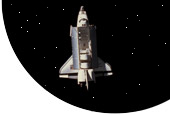MSNBC - Hubble debate -- a lot of sound and fury
http://msnbc.msn.com/id/4580820/
Hubble debate -- a lot of sound and fury
Politics and posturing aside, NASA's actually right this time
COMMENTARY By James Oberg, NBC News space analyst
Special to MSNBC
Updated: 9:49 p.m. ET March 22, 2004
HOUSTON - The premature termination of the Hubble telescope's mission is dismaying, even heart-breaking. But even more appalling has been the aftermath of the decision. While NASA made ghastly blunders in announcing and explaining the decision to cancel a needed repair mission, the public furor that has ensued is based on fundamental misunderstandings and misconception mixed with posturing and politics.
Lost in all this senseless noise is a sober discussion of what needs to be done now to maximize the future scientific value of the still-very-much-alive space eye. And as NASA faces the challenge of responding to the new White House "space vision" to fly safely beyond low Earth orbit, it needs to preserve and widen its commitment to improving its own philosophical approach to risk management -- a positive trend that lies hidden behind the controversy over Hubble.
Heed lessons of Columbia
NASA Administrator Sean O’Keefe recently released a lengthy defense of the rationale behind canceling the repair mission cancellation rationale, and even though it came out far too late, it deserves attention because it makes very good points that are too widely overlooked.
In preparing the next shuttle mission, O’Keefe writes, “NASA has uncovered a number of problems that had previously gone undetected,” which has “deferred Space Shuttle launch milestones.” I wish he’d just used English -– “has delayed the next launch” –- but the point is valid.
As a result, after resuming assembly and servicing and resupplying the International Space Station –- NASA’s priority project, involving major foreign partnerships -– O’Keefe writes that “the earliest NASA could launch a servicing mission to the HST ... would be Spring 2007.”
That’s three years from now. Even if the mission was scheduled, in the intervening years Hubble still faces a significant likelihood of battery and/or gyroscope failure. In the same period, stand-alone tile inspection and repair procedures must also be developed that would be unique to a servicing mission.
“If any of the many elements do not develop as planned,” O’Keefe writes, “the telescope may cease operations before a successful mission could be mounted.” Hence the need –- already recognized at NASA –- for exploring all automated servicing options.
Meantime, loading a new time-critical responsibility on the shuttle engineers and managers would be a great leap backwards from the culture of higher safety awareness that the Columbia investigation board urged NASA to implement. The Columbia report, issued only last August, blamed the loss of the space shuttle and the deaths of its seven-member crew on NASA's habit of relaxing safety standards to meet financial and time constraints and warned of future tragedy if the space agency's "broken safety culture" continued.
As it is, return-to-flight planners already are under the deadline gun of the faltering space station, with its creaky oxygen system and hiccuping gyroscopes. It makes no sense to add another layer of pressure to "get the bird in the air," no matter the shortcuts.
Real risks of Hubble mission
A lot of former astronauts, including some who worked on the Hubble, say they would do it again, despite the risk. Ships are safe in harbor, goes the macho mantra of astronauthood, but that’s not what ships are for. One of them recited the famous two-century-old quotation from John Paul Jones: “Give me a fast ship for I intend to sail in harm's way.”
Such posturing (and posturing it is, since there is actually zero chance that any of these volunteers would actually be tapped for the mission) ignores certain factors. I don’t mind people stepping forward, and I say, let 'em go, as long as they bring their own spaceship, too. But when you talk about MY ship (as a part-owner taxpayer), I want my hired experts to make the judgment call on letting it fly or not.
After all, we only have three space shuttles left. We need to protect them a lot more than we'll need to protect the planned Constellation-class expendable vehicles with an open production line. When Jones went into harm’s way, he had a fleet (and active naval yards) and could afford to loose a few ships. We can’t.
Some “leaked” memos from anonymous “NASA insiders” allege the Hubble mission is actually safer than a space station mission. (This despite the fact that the shuttle crew can actually take refuge in the space station should they need to, and from there inspect and repair their vehicle.) I’ve seen these reports and as a veteran of 22 years at Mission Control in Houston, I don’t see any indications that the authors have the slightest working familiarity with shuttle operations.
Hubble is in a near-equatorial orbit that requires launching shuttles east over the open Atlantic, far from the emergency landing sites on the U.S. East Coast that could save a limping shuttle bound for the station’s orbit. And Hubble is almost twice as high as the station, presenting a challenging propulsion task to return to Earth –- some hardware or fuel supply problems that would merely annoy a shuttle at the space station could doom it on a telescope mission.
Publicity and politics
NASA isn't blameless, of course. The space agency has painted itself into a public relations corner with its hype of Hubble (false-color artwork of the images included), and the impression that for all its undeniable advantages, it is the only way to conduct astronomy.
Without Hubble, an inattentive reader might suspect from the propaganda, humanity’s eyes on the universe will close. But observatories here on Earth are advancing in capabilities on half a dozen technological fronts -- even as their accomplishments often go unsung both by NASA and the news media at large.
For example, the planetoid Sedna was not discovered from any of NASA's space-based Great Observatories, but from Mount Palomar in California. Yet NASA hosted the press release on its Web site devoted to the Spitzer Infra-Red Space Telescope, whose main contribution to the discovery was an upper limit on the planetoid’s size based on the fact that the space telescope could NOT detect Sedna.
Nor is it unprecedented to shut down a working science satellite, despite accusations such as the one from journalist Peter Dizikes in the Boston Globe a few days ago: “Astronomers and historians of science alike say they cannot remember any other time in modern scientific history when the world's most powerful telescope was simply abandoned, without a better one ready to replace it,” he wrote. He then quoted Harvard emeritus professor Owen Gingerich as saying, "Usually other instruments are there and taking over. ... You don't have this interim gap where you throw away an instrument that is producing heavily in anticipation of something else."
“Usually” is the operative word here, because (unlike Dizikes’s interpretation) it doesn’t mean “always”. And in fact NASA several years ago did “abandon” an earlier component of its fleet of Great Observatories on safety grounds even though there was no replacement payload. Failures in the Compton Gamma Ray
Observatory's stabilization system threatened an out-of-control fall to Earth of particularly-dense structural materials, and based on a defined standard of risk level, NASA made the unpopular decision to deorbit the payload deliberately.
Dizikes expresses disbelief in O’Keefe’s explanation: “The agency says its rationale is safety, but skeptics believe the Hubble is being sacrificed to pay for President Bush's goal of sending astronauts to Mars”, he wrote, without actually quoting anyone saying that. Then in his summing up, he accepted this suggestion as proven: “Ultimately, any choice between Hubble and a manned Mars mission is a choice between two distinct modes of astronomical exploration,” he concluded. “Mars presents a specific, long-term undertaking -- and an all-or-nothing gamble. Hubble would provide a wider-ranging, more immediate, and steadier flow of discoveries.”
Perhaps this is a foretaste of the politicization of the Hubble debate. Dizikes has impeccable credentials as a technology journalist, but he also recently wrote an article for ‘Salon’ about “What Kerry Has To Do To Defeat Bush”. Making the Hubble decision a minor key for political attack could well be one such tactic.
That’s a sure way to introduce further irrationality into an already overheated debate characterized by lots of smoke and very little light, which is an insult to the true mission of Hubble: To see things more clearly. |

